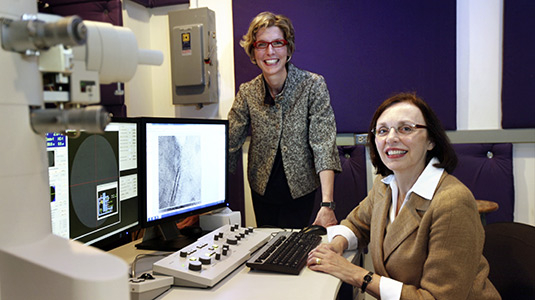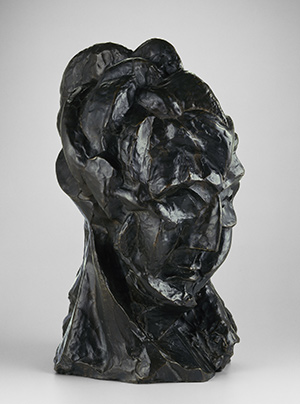Northwestern-Art Institute Partnership Expands With Mellon Grant
Center will be a new national model of collaborative scientific research in the arts

Northwestern University has received a $2.5 million grant from the Andrew W. Mellon Foundation to establish the Center for Scientific Studies in the Arts, expanding an innovative partnership between the University and the Art Institute of Chicago that has led to unlocking secrets about many of the museum’s masterpieces and developing new methods and technologies to investigate art.
Breaking new ground, the conservation science partnership, funded over six years, will offer its scientific tools and expertise to users from across the country.
In the United States, scientific research on cultural heritage objects typically is conducted within the boundaries of a specific museum or cultural institution, with only a few dozen such institutions equipped with the necessary tools and expertise nationally.
“I am thrilled that what we have accomplished over the past eight years has been recognized as valuable,” said Katherine T. Faber, a Walter P. Murphy Professor in materials science and engineering at Northwestern. “Now, we are ready to build upon this solid foundation to offer our expertise to others beyond our institutions.”
Faber and Francesca Casadio, the Andrew W. Mellon Senior Conservation Scientist at the Art Institute, launched the museum-academic partnership in 2004 with Mellon support.
Many of the partnership’s remarkable discoveries over the years have been woven into major exhibitions at the Art Institute, including “Matisse: Radical Invention, 1913-1917” in 2010 and “Watercolors by Winslow Homer: The Color of Light” in 2008.

The upcoming show “Picasso and Chicago” (Feb. 20 to May 12) will include findings from a study of Modern bronze sculptures in which Northwestern and Art Institute researchers traced some of Picasso’s unmarked sculptures to the Valsuani foundry in Paris, based on material evidence.
The new center will serve as a collaborative hub, facilitating interdisciplinary research partnerships in art studies and conservation on a national scale. Academic researchers and scholars in training will meet and engage in mutual learning with scientists, conservators and curators.
Conservation scientists in and outside Chicago have learned about the partnership’s work through the Art Institute’s exhibitions as well as academic papers and seminars. They have been eager to have the opportunity to study their own treasures, using the latest science and engineering tools offered by Northwestern and the Art Institute.
“Art and technology are prime material evidence of humanity’s accomplishment,” Casadio said. “By bringing the two together in this center, we will have a chance to enhance our understanding of the world’s shared cultural objects and preserve them for future generations.
“This landmark initiative represents a tectonic shift from the isolated museum scientist to a dynamic hub that will serve as incubator of new ideas and significantly accelerate the rate of discoveries by providing the latest technological innovations brewing in the academic environment,” she said.
Casadio and Faber will be co-directors of the Center for Scientific Studies in the Arts, which will be based physically at Northwestern. The center will be staffed by a senior scientist and two postdoctoral fellows and will act as an umbrella for all research and educational activities related to the conservation science partnership.
Interested parties from museums and cultural institutions will be required to submit proposals for merit review to study objects in their own collections or perform object-inspired research. Faber and Casadio expect three to five major projects and up to 10 minor projects to be carried out each year by researchers from inside and outside Northwestern and the Art Institute.
“The new center will be built on the solid foundation of collaborations between the Art Institute of Chicago and Northwestern University that have long been nurtured by the enlightened support of the Mellon Foundation,” said Douglas Druick, president and Eloise W. Martin Director of the Art Institute of Chicago.
“As the first such initiative in the United States, the center will inspire a new model for research partnerships between museums and academia, and we are especially excited by the promise of bringing museum professionals, researchers and students together to contribute original and groundbreaking research to their respective fields,” he said. “We remain exceedingly grateful to the Mellon Foundation for the important scholarship made possible by their support of these key partnerships and look forward to sharing our findings with the broadest audiences possible in the coming years.”
“The new center promises to enhance research and education on works of cultural heritage with new partners at museums and cultural institutions who would benefit from the scientific tools and expertise we collectively offer,” Northwestern Provost Daniel Linzer said.
“I have appreciated the many discoveries this highly productive partnership in conservation science has made possible and look forward to future findings as the collaboration expands its scope,” he said.
Linzer noted the partnership and its center address all four core areas of the University’s strategic plan: to discover creative solutions, integrate learning and experience, connect our community and engage with the world.
For more information on the Center for Scientific Studies in the Arts, go to http://www.nuaccess.northwestern.edu.
Brief summaries of some of the groundbreaking discoveries resulting from the Northwestern-Art Institute partnership follow:
- “Head of a Woman (Fernande)” by Pablo Picasso. Findings from a study analyzing the metal alloys of Modern sculptures will be part of the Art Institute’s upcoming major exhibition “Picasso and Chicago” (Feb. 20 to May 12). A research team determined that many of the museum’s Picasso sculptures are made of high-zinc brass alloys, a fact that enabled them to trace the works to the Valsuani foundry in Paris.
- “Fernande,” on the other hand, has a low-zinc bronze composition that is more typical of sand-cast sculptures, but the piece is unlike those cast at the Rudier foundry. The search for its unknown casting foundry is one of the open questions the new Center for Scientific Studies in the Arts hopefully will be able to address by extending the alloy study to a wider range of collections.
- “Bathers by a River” by Henri Matisse. Researchers from Northwestern’s department of electrical engineering and computer science developed imaging technology to colorize archival black-and-white photographs of early versions of this painting. This provided insights into Matisse’s working methods and the coloristic development of this masterpiece over time and was part of the Art Institute’s 2010 show “Matisse: Radical Invention, 1913-1917.”
- “For to be a Farmer’s Boy” by Winslow Homer. Conservators discovered the painting’s white skies were originally painted in unstable red and orange dyes that have almost completely faded. A team including Northwestern chemists has been working to determine exactly what the original colors were. The findings were featured in the museum’s 2008 exhibition “Watercolors by Winslow Homer: The Color of Light.”
- “A Sunday on La Grande Jatte - 1884” by Georges Seurat. The luminous yellow in this painting began to change within years of Seurat’s completing the masterpiece, but no one knew why. Scientists determined that exposure to a humid climate and burning coal caused the darkening of the zinc yellow pigment used by Seurat.
- “Sketch of Margaret Sloane, Looking Right” by Mary Cassatt. A research team removed tiny colored flecks from this pastel study and examined them using a highly sensitive technique called surface-enhanced Raman spectroscopy. The researchers were able to detect and identify organic pigments that could be matched to pastel sticks in Mary Cassatt’s paint box.